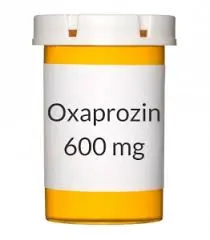Oxaprozin
Description
Oxaprozin, also known as oxaprozinum, is a nonsteroidal anti-inflammatory medication that is used to treat osteoarthritis and rheumatoid arthritis-related joint pain, swelling, stiffness, and inflammation. It is a chemical derivative of propionic acid. Oxaprozin is an NSAID used to treat osteoarthritis, rheumatoid joint inflammation, and adolescent rheumatoid joint inflammation.
- Metabolism: Liver – 65% oxidation and 35% glucuronic acid conjugation. 5% are active phenolic metabolites
- ATC code: M01AE12 (WHO)
- Bioavailability: 95%
- Brand Names – Daypro
- Generic Name – Oxaprozin
- Type – Small Molecule
- Groups – Approved
- Chemical Formula – C18H15NO3
- Pregnancy category: C
Synonyms
- Oxaprozin
- Oxaprozina
- Oxaprozine
- Oxaprozinum
Associated Conditions
- Osteoarthritis (OA)
- Rheumatoid Arthritis
- Juvenile idiopathic arthritis
Background
Oxaprozin is a non-steroidal anti-inflammatory drug (NSAID) that is used to treat osteoarthritis and rheumatoid arthritis-related joint pain, swelling, stiffness, and inflammation.
What is oxaprozin?
Oxaprozin is a nonsteroidal calming drug (NSAID) that is utilized to treat agony or irritation brought about by osteoarthritis or rheumatoid joint pain in grown-ups. Rheumatoid arthritis is also treated with oxaprozin in children who are at least 6 years old. There are additional uses for oxyprozin that are not included in this medication guide.
Why is this medication prescribed?
Oxaprozin is used to treat osteoarthritis (arthritis caused by a breakdown of the lining of the joints) and rheumatoid arthritis (arthritis caused by swelling of the lining of the joints) pain, tenderness, swelling, and stiffness. Oxaprozin is also used to treat juvenile rheumatoid arthritis pain, tenderness, swelling, and stiffness in children over the age of six. Oxaprozin belongs to the class of drugs known as nonsteroidal anti-inflammatory drugs (NSAIDs). It works by stopping the body from making a substance that makes you feel sick, have pain, and have a fever.
How should this medicine be used?
Oxaprozin can be taken orally as a tablet. Typically, it is taken once or twice every day. Oxaprozin can be taken at any time during the day. Follow the directions on the label of your prescription with care, and if you have any questions, ask your doctor or pharmacist. Oxaprozin should be taken as directed. Do not take it more continually or less frequently than your doctor has instructed.
How to use Oxaprozin
Before you start taking oxaprozin and every time you get a refill, read the Medication Guide that your pharmacist gives you. If you have any questions, speak with your medic and/or pharmacist. Follow your medic’s instructions and take this remedy orally, usually once daily. Unless your doctor tells you otherwise, sip a full glass of water (8 ounces, or 240 milliliters). After taking this medication, do not sit or lie down for at least ten minutes. Take this remedy with food, milk, or an antacid if you undergo stomach upset while taking it.
Your medical condition, body weight, and response to treatment determine the dosage. Adults should consume no more than 26 milligrams per kilogram or 1,800 milligrams per day, whichever is less, according to the manufacturer. Utilize this medication at the lowest effective dose for the shortest amount of time possible to reduce the likelihood of side effects like stomach bleeding. Do not take this medication more repeatedly or at a higher dose than specified. Continue taking it according to your doctor’s instructions if you have a chronic condition like arthritis. Talk to your medic or pharmacist about the advantages and risks. When this medication is taken regularly, it may take up to two weeks for some conditions, like arthritis, to show their full benefits.
Other uses for this medicine
This prescription might be recommended for different purposes; For more information, consult your physician or pharmacist.
Pharmacodynamics
Oxaprozin is an analgesic and antipyretic nonsteroidal anti-inflammatory drug (NSAID). Oxaprozin is used to treat moderate pain, rheumatoid arthritis, osteoarthritis, and dysmenorrhea.
Mechanism of action
Oxaprozin’s anti-inflammatory effects are thought to be caused by blocking prostaglandin synthesis and inhibiting platelet cylooxygenase. The hypothalamic effect, which causes an increase in peripheral blood flow, vasodilation, and subsequent heat dissipation, may account for the antipyretic effects. Oxaprozin is a non-selective non-steroidal anti-inflammatory drug (NSAID), and a cell assay system that exhibits lower selectivity for COX-2 suggests higher selectivity for COX-1.
Absorption
After being taken orally, 95 percent of oxaprozin is absorbed. Oxaprozin’s absorption rate may be slowed by food, but the amount absorbed remains the same. Oxaprozin absorption is not significantly influenced by antacids.
The volume of distribution – 11 to 17 L/70 kg
Protein binding = >99.5% bound to albumin
Metabolism
Hepatic. Oxaprozin’s major conjugated metabolites, ester and ether glucuronide, lack significant pharmacologic activity.
Route of elimination
Based on its physical and chemical properties, it is anticipated that oxaprozin will be excreted in human milk; However, it has not been determined how much oxaprozin is excreted in breast milk. The liver metabolizes oxaprozin to a level of approximately 95%. In the urine, only about 5% of the oxaprozin dose is eliminated unchanged. As a metabolite, 35% of the dose is excreted in the feces and 65% is excreted in the urine. A minor route for unchanged oxaprozin is biliary excretion. In human feces or urine, several oxaprozin metabolites have been found.
Half-life – 54.9 hours
Clearance – Not Available
Pharmacogenomic Effects/ADRs – Not Available
Food Interactions
- Take it with food. Take once daily after breakfast. The extent of absorption is not facilitated by food.
What special precautions should I follow?
Before taking oxaprozin,
- If you have an allergy to oxaprozin, aspirin, other NSAIDs like ibuprofen (Advil, Motrin), naproxen (Aleve, Naprosyn), or any of the inactive ingredients in oxaprozin tablets, tell your doctor and pharmacist. Request a list of the inactive ingredients from your apothecary.
- The vitamins, nutritional supplements, herbal products, and prescription and nonprescription medications that you are taking or plan to take should be disclosed to your physician and pharmacist. Be sure to mention any of the following, in addition to the medications listed in the Important Warning section: benazepril (Lotensin in Lotrel), captopril (Vasotec in Vaseretic), enalapril (Vasotec in Vaseretic), fosinopril (Monopril), lisinopril (Zestoretic), moexipril (Univasc), perindopril (Aceon in Prestalia), quinapril (Accupril in Quinaretic Angiotensin receptor blockers (ARBs) such as telmisartan (Micardis, in Micardis HCT, in Twynsta), valsartan (in Exforge HCT), eprosartan (Teveten), irbesartan (Avapro, in Avalide), losartan (Cozaar, in Hyzaar), olmesartan (Benicar, in Azor, in Benicar beta blockers like atenolol (Tenormin, also known as Tenoretic), labetalol (Trandate), metoprolol (Lopressor, Toprol XL, or Dutoprol), nadolol (Corgard, also known as Corzide), and propranolol (Hemangeol, Inderal, and Innopran); diuretics, or “water pills” glyburide (micronase and glynase); lithium, or a Lithobid; and methotrexate, including Otrexup, Rasuvo, and Trexall It’s possible that your doctor will need to adjust the dosage of your medication or closely monitor you for side effects.
- If you have asthma or have ever had it, tell your doctor, especially if you also frequently have a stuffy or runny nose or nasal polyps; cardiovascular breakdown; hands, feet, ankles, or lower legs swelling; or liver or kidney problems.
- Inform your doctor if you are breastfeeding or planning to become pregnant. If taken around 20 weeks or later during pregnancy, oxyprozin may harm the fetus and hinder delivery. Unless your doctor tells you to, you should not take oxaprozin until you are at least 20 weeks pregnant. Call your doctor if you become pregnant while taking oxaprozin.
- If you are 65 years of age or older, discuss the benefits and risks of taking oxaprozin with your doctor. Oxaprozin should only be taken in lower doses for a short time by older adults because taking higher doses on a regular motivation may not be as effective and is more likely to cause serious side effects.
- Inform the dentist or doctor that you are taking oxaprozin if you are having surgery, including dental surgery.
- Plan to wear sunblock, sunglasses, and protective clothing to avoid excessive or prolonged exposure to the sun. Your skin may become more sensitive to sunlight after taking oxaprozin.
When taking oxaprozin, what should I avoid?
Avoid drinking. Drinking a lot can make your risk of stomach bleeding go up. While taking oxaprozin, do not take aspirin. Before utilizing other medicines to treat pain, fever, swelling, or cold/flu symptoms, talk to your medic and/or pharmacist. They might have components that are similar to oxaprozin, like naproxen, aspirin, ibuprofen, or ketoprofen. Oxaprozin could make you burn from the sun all the more without any problem. Keep away from daylight or tanning beds. When you are outside, put on protective clothing and use sunscreen with an SPF of 30 or higher.
What special dietary instructions should I follow?
Unless your medic tells you otherwise, resume your normal diet.
What should I do if I ignore a dose?
When you remember, take the dose you missed. On the other hand, if it is getting close to the time for the next dose, skip the missed one and stick to your usual schedule.
Oxaprozin Pregnancy Warnings
Creature studies have uncovered proof of expanded pre-and post-implantation misfortune following the organization of prostaglandin amalgamation inhibitors during pregnancy. At doses of 7.5 mg/kg/day or higher (0.1 times the maximum daily dose for humans), malformed fetuses were rare. Controlled data on human pregnancy do not exist. Beagle dogs treated with 37.5 mg/kg/day (0.7 times the maximum recommended daily dose for humans based on body surface area) for 42 days or six months developed testicular degeneration.
Drug Safety Communication from the US FDA (10-2020): The FDA is now requiring that NSAID labels include a new warning about the risk of fetal kidney problems that could lead to low amniotic fluid. After 20 weeks of pregnancy, NSAIDs should not be taken by pregnant women, according to the FDA. The FDA has obtained 35 reports of low levels of amniotic fluid and/or kidney troubles in pregnant women who took NSAIDs. Five children died; There was evidence of low amniotic fluid in two of them, but there was no evidence of low amniotic fluid in three of them. When the woman was 20 weeks pregnant, the low amniotic fluid began. 11 pregnant women conveyed low levels of amniotic fluid, and the fluid volume returned to normal when the NSAID was stopped. In the medical literature, the use of nonsteroidal anti-inflammatory drugs (NSAIDs) has been linked to low levels of amniotic fluid for a range of periods from 48 hours to several weeks. Lung maturation may be delayed and limb contractures may occur as complications of prolonged oligohydramnios. After the drug was approved, invasive procedures like exchange transfusion or dialysis were required in a few cases of impaired neonatal renal function. In other instances, the condition disappeared within three to six days of stopping the NSAID use, only to return when the same NSAID was used again.
Female fertility may be affected by NSAIDs; Women who are having trouble getting pregnant or who are having tests done to see if they have infertility should think about stopping taking NSAIDs. The administration should not be done during labor and delivery; It’s possible that labor won’t start as soon as expected and that there will be more stillbirths.
US FDA has not assigned a pregnancy category: The US FDA has corrected the pregnancy marking rule for physician-endorsed drug items to require naming that incorporates a synopsis of chance, a conversation of the information supporting that outline, and significant data to assist medical services suppliers with pursuing recommending choices and guidance ladies about the utilization of medications during pregnancy.
NSAIDs should be avoided beginning at 20 weeks of gestation and resuming after that. Risk Recap: Not assigned The use of nonsteroidal anti-inflammatory drugs (NSAIDs) in pregnant women after 30 weeks of gestation may result in the premature closure of the fetal ductus arteriosus; After 20 weeks of pregnancy, taking nonsteroidal anti-inflammatory drugs (NSAIDs) can cause fetal renal dysfunction, which can lead to oligohydramnios and, in some cases, neonatal renal impairment.
Oxaprozin Breastfeeding Warnings
Depending on how important the drug is to the mother, it should be decided whether to stop taking it or continue breastfeeding. Absorbed by the milk of humans: Obscure Ousted into milk from creatures: Comments: Yes, it is unknown how the nursing infant will be affected. Due to the lack of published clinical studies related to breastfeeding, other agents may be selected.
What side effects can this medication cause?
There may be side effects from oxyprozin. If any of these symptoms persist or evolve severely, confer your physician:
- diarrhea
- constipation
- vomiting
- gas or bloating
- drowsiness
- difficulty sleeping
- confusion
- depression
- dizziness
- headache
- ringing in the ears
Some side effects can be serious.
Call your doctor right away if you experience any of the symptoms listed below or in the Important Warning section. Do not take any more oxaprozin until you speak to your medic:
- Stomach bleeding: feeling faint, vomiting blood, bloody or dark stools, severe stomach pain and/or discomfort
- Heart attack: chest discomfort or tightness, pain that radiates up to your shoulder, arm, neck, and/or jaw
- Stroke: chest pain, trouble breathing, weakness in one part of your body or face, and also slurred speech
- Heart failure: difficulty breathing, swelling, fast heartbeat
- Liver problems: swelling of your stomach, yellowing of your skin or the whites of your eyes, confusion, dark and/or brown urine
- Kidney problems: tiredness, dry and itchy skin, low appetite, urinating less than usual, foamy or bloody urine, and also muscle cramps
- Allergic reactions: hives, rash, blisters, swelling of the lips or tongue, and difficulty in breathing
- Serious skin reactions: skin reddening, blisters, rash
Other side effects of oxyprozin may occur. If you experience any unusual side effects while taking this drug, confer with your physician. You or your doctor can report a serious side effect to the MedWatch Adverse Event Reporting program of the Food and Drug Administration (FDA) online or by phone at 1-800-332-1088.
What should I know about the medication’s storage and disposal?
Keep this medication in the original container and out of the reach of children. It should be kept at room temperature, out of condensation and heat (not in the bathroom). Because many medicines, mainly creams, patches, eye drops, inhalers, and weekly pills, are not child-resistant and young children can easily open them, it is essential to keep all drugs out of children’s sight and/or reach. To shield small kids from harm, consistently secure well-being covers and quickly place the prescription in a protected area – one that is up into the clouds and far away from them and reach.
To prevent pets, children, and others from consuming unneeded medications, special disposal methods should be used. However, you should not discard this medication. Instead, the best way to get rid of your medication is through a program called a medicine take-back. If you do not have access to a take-back program, you can learn more about them by speaking with your pharmacist or by contacting your local department of garbage or recycling.
In case of an emergency or overdose
Contact the poison-manipulating helpline at 1-800-222-1222 for the possibility of an overdose. Call 911 right away if the victim has collapsed, had a seizure, is having trouble breathing, or cannot be awakened.
Symptoms of overdose may include the following:
- lack of energy
- drowsiness
- upset stomach
- vomiting
- stomach pain
- bloody, black, or tarry stools
- vomiting a significance that is bloody or glances like coffee grounds
- difficulty breathing
- seizures
- coma (loss of consciousness for some time)
Overdose
Contact 911 instantly if a person has taken an excessive amount of medication and is experiencing serious symptoms such as unconsciousness or difficulty breathing. Otherwise, immediately contact a poison control center. Canadians can also get in touch with a provincial poison control center. Extreme drowsiness, loss of consciousness, slowed or shallow breathing, severe stomach pain, and vomit that looks like coffee grounds are all signs of an overdose.
Notes
Do not give this medicine to anyone else. While you are taking this medication, you may have your blood pressure, complete blood count, and kidney or liver function tested. Keep track of all lab and medical appointments. For more information, consult your physician. Your doctor-approved non-drug arthritis treatment, such as losing weight if necessary and engaging in strengthening and conditioning exercises, may assist in enhancing your flexibility, range of motion, and joint function. For more details, talk to your medic.
Missed dose
In the event that you forget to take a dose, take it as soon as you remember. If the missed dose is close to the next one, skip it. To catch up, do not crease the dose.
Storage
Keep away from moisture and light at room temperature. Keep it out of the bathroom. Keep medications away from pets and children. Try not to wash drugs away forever or empty them into a channel except if trained to do as such. Properly dispose of this product when it has expired or is no longer required. Confer your pharmacist or the local waste management company.
What other information should I know?
Inform your doctor and the laboratory staff that you are taking oxaprozin before any tests. Do not provide your pills or drugs to anyone else. Your prescription and over-the-counter medications, as well as all of your supplements, vitamins, and other dietary supplements, must all be documented in writing. At the point when you visit a specialist or are owned up to an emergency clinic, you ought to carry this rundown with you. In addition, it is crucial information to have readily available in the event of an emergency.
Pharmacist tips for Oxaprozin (Daypro)
- You can take oxaprozin (Daypro) regardless of food. However, to avoid experiencing an upset stomach as a side effect of the medication, it is best to take it with food or milk. Simply realize that food can slow how long it takes for your body to assimilate the medicine. This indicates that taking oxaprozin (Daypro) with food may delay the onset of its pain relief effects.
- Drinking alcohol while taking oxaprozin (Daypro) can make you more likely to get stomach bleeds and ulcers.
- Other nonsteroidal anti-inflammatory drugs (NSAIDs) like ibuprofen (Motrin, Advil) should not be taken with oxaprozin (Daypro). You increase your risk of stomach bleeding by doing so. Over-the-counter pain and cold medications often contain NSAIDs. If you’re not sure if you’re already taking an NSAID, check with your doctor or pharmacist.
- Oxaprozin interacts with other medications, like blood pressure medicine, aspirin, and some antidepressants. Before starting oxaprozin (Daypro), be sure to tell your doctor about all the medications you are currently taking or are planning to take. They can ensure that you can take your medications together safely.
- Your skin may become more sensitive to the sun or ultraviolet (UV) light when you take Oxaprozin (Daypro). Because of this, you are more likely than ever to get sunburns. When you go outside, wear long-sleeved clothing and sunscreen to protect your skin. Also, don’t spend too much time in the sun or light.
Individualization of Dosage
The dose and frequency of DAYPRO therapy should be adjusted according to the needs of each patient after observing the response to the initial treatment. For osteoarthritis, juvenile rheumatoid arthritis, and rheumatoid arthritis, the lowest effective dose of DAYPRO should be used as the dosage to minimize side effects. The maximum daily dose of DAYPRO for adults in divided doses is 1800 mg (or 26 mg/kg, whichever is lower). Children have not been studied at doses above 1200 mg. 600 mg once daily should be used to begin treatment for patients with low body weight. 600 mg once daily should also be taken by patients on dialysis or with severe renal impairment to begin treatment. If these patients don’t get enough relief from their symptoms, the dose can be slowly increased to 1200 mg, but only if careful monitoring is done.
In adults, when a quick onset of action is required, the pharmacokinetics of oxaprozin permit a one-time loading dose of 1200 mg to 1800 mg (not to exceed 26 mg/kg). Patients who weigh more than 50 kilograms, have normal renal and hepatic function, are at low risk for peptic ulcer, and whose disease severity justifies maximal therapy should only receive daily doses of more than 1200 mg. Before moving on to higher doses, doctors should make sure that patients can tolerate doses between 600 and 1200 mg/day without experiencing any adverse effects for dermatology, kidney, hepatic, or gastroenterology. Even though patients who are unable to tolerate single doses may try divided doses, the majority of patients will tolerate once-a-day dosing with DAYPRO.
IMPORTANT WARNING:
Other than aspirin, people who take nonsteroidal anti-inflammatory drugs (NSAIDs) like oxaprozin may be more likely to have a heart attack or stroke than people who don’t. These things can happen without warning and could cause death. This could be more likely to happen to people who take NSAIDs for a long time. If you have recently experienced a heart attack, you should not take an NSAID like oxaprozin unless your doctor tells you to. If you smoke, tell your doctor if you have diabetes, high cholesterol, high blood pressure, or heart disease or if you have ever had one of these conditions. If you experience any of the following signs, you should immediately seek emergency medical attention: chest pain, difficulty breathing, weakness in one side or part of the body, or slurred speech are all symptoms.
Oxaprozin and other nonsteroidal anti-inflammatory drugs (NSAIDs) can lead to stomach or intestine ulcers, bleeding, or holes. These problems can happen at any time during treatment, they don’t always show up as symptoms, and they could kill you. People who are older, in poor health, and have been taking NSAIDs for a long time may be at a higher risk. or consume a significant amount of alcohol while taking oxaprozin. If you take any of the following medications, tell your doctor. “blood thinners,” or anticoagulants like warfarin (Coumadin, Jantoven); aspirin; other NSAIDs like ibuprofen (Advil, Motrin) and naproxen (Aleve, Naprosyn); oral steroids like prednisone (Rayos), methylprednisolone (Medrol), and dexamethasone citalopram (Celexa), fluoxetine (Prozac, Sarafem, Selfemra, in Symbyax), fluvoxamine (Luvox), paroxetine (Brisdelle, Paxil, Pexeva), and also sertraline (Zoloft) are examples of selective serotonin reuptake inhibitors (SSRIs). or serotonin-norepinephrine reuptake inhibitors (SNRIs) like duloxetine (Cymbalta), desvenlafaxine (Khedezla, Pristiq), and venlafaxine (Effexor XR). Also, tell your doctor if you’ve ever had ulcers, stomach or intestine bleeding, or any other bleeding disorder. Stop taking oxaprozin and contact your doctor if you experience any of the following symptoms: stomach pain, heartburn, vomiting something that looks like blood or coffee grounds, blood in the stool, and/or stools that are black and tarry
Keep all of your lab and doctor’s appointments. Your doctor will likely order certain tests to check your body’s response to oxaprozin and closely monitor your symptoms. Be sure to let your doctor know how you’re feeling so that he or she can prescribe the right amount of medication to treat your condition with the fewest possible serious side effects.
When you begin taking oxaprozin, your doctor or pharmacist will provide you with the manufacturer’s patient information sheet (Medication Guide) each time you get a refill on your prescription. If you have any questions, make sure to consult your physician or pharmacist. The Medication Guide can also be obtained from the manufacturer’s website or the Food and Drug Administration (FDA).
Precautions of oxaprozin drug
If you are allergic to oxaprozin, tell your doctor or pharmacist before taking it; aspirin or other nonsteroidal anti-inflammatory drugs (like ibuprofen, naproxen, or celecoxib); or if you are allergic to anything else. This product may contain inactive ingredients, which could cause problems like allergic reactions. For further information, consult your pharmacist.
- Inform your doctor or pharmacist of your medical history before taking this medication, especially of: liver disease, stomach/intestine/esophagus problems (such as bleeding, ulcers, recurring heartburn), heart disease (such as a history of a heart attack), high blood pressure, stroke, blood disorders (such as anemia, bleeding/clotting problems), growths in the nose (nasal polyps), and asthma (including a history of worsening breathing after taking aspirin or other NSAIDs).
- Oxaprozin is one of the NSAIDs that can occasionally cause kidney problems. Problems are more likely to occur if you are dehydrated, have heart failure or kidney disease, are older, or take certain medications (see also the Drug Interactions section). To avoid becoming dehydrated, obey your medic’s education to drink a lot of fluids, and if your urine volume changes, inform your medic right away. Inform your dentist or doctor about all of your medications, herbal products, and nonprescription medications before surgery.
- You might become drowsy or dizzy from this drug. Both alcohol and cannabis have the potential to make you more drowsy or nauseous. Do not drive, operate machinery, or engage in any activity that requires you to be alert until it is safe to do so. Consult your doctor if you are using marijuana (cannabis).
- This medication may cause bleeding in the stomach. Consuming alcohol and tobacco on an everyday basis, particularly when taking this medication, may increase your risk of stomach bleeding. Stop drinking alcohol and smoking. For more details, talk to your apothecary or medic.
- You might evolve more prone to sunburn from taking this drug. Reduce your time spent in the sun. Avoid sunlamps and tanning booths. When you are outside, spread sunscreen and wear protective gear. If you get sunburned, have skin blisters, or if you have redness, tell your doctor right away.
- When taking this medication, older people may be more likely to have stomach or intestinal bleeding, kidney problems, a heart attack, or a stroke.
- Discuss the benefits and risks of this medication with your doctor(s) if you are a woman of childbearing age. Inform your medic if you are pregnant or planning to evolve pregnant. This medication has the potential to cause harm to an unborn child and disrupt normal labor and delivery. Between the ages of 20 and delivery, it should not be used during pregnancy. If your doctor decides that you need to take this medication between 20 and 30 weeks of pregnancy, you should take the lowest effective dose for as little time as possible. After 30 weeks of pregnancy, do not take this remedy.
It is not known if this remedy gives into breast milk. Talk to your doctor before starting a breastfeeding program.
Interactions of oxaprozin drug
If your medications interact with one another, their effects may be altered or you may experience more serious side effects. All possible interactions between medications are not covered in this record. Together with your doctor and pharmacist, make a list of all the herbal products you use as well as the prescription and nonprescription products you use. Without consulting your physician, do not begin, prevent, and/or alter the dosage of any drug.
Aliskiren, ACE inhibitors (like captopril and lisinopril), angiotensin II receptor blockers (like losartan and valsartan), cidofovir, lithium, methotrexate, and “water pills” (like diuretics like furosemide) may interact with this medication. When taken with different medications that can likewise cause death, this drug might make draining more probable. Antiplatelet medications like clopidogrel and “blood thinners” like dabigatran, enoxaparin, and warfarin are two examples.
Aspirin, nonsteroidal anti-inflammatory drugs (NSAIDs) like celecoxib, ibuprofen, and ketorolac, among others, are common pain relievers and fever reducers on prescription and nonprescription medications. If you take these medications together, you might experience more side effects because they are similar to oxaprozin. However, if your doctor has prescribed a low dose (typically 81-162 milligrams per day) of aspirin to prevent heart attack or stroke, you should continue taking it unless your doctor tells you otherwise. For more knowledge, talk to your pharmacist or medic.
Some laboratory tests may be affected by this product, leading to inaccurate results. Inform all of your doctors and lab personnel that you are taking this medication
FAQ
Can oxaprozin (Daypro) only be taken for pain relief?
For arthritis pain, Oxaprozin (Daypro) is rarely used as needed. Typically, it is taken on an everyday basis. Talk to your doctor if you think you don’t need to take oxaprozin (Daypro) every day. They can talk about the options that will work best for you, like taking oxaprozin (Daypro) as needed or switching to another pain medication.
If I’m pregnant, can I take Daypro (oxaprozine) safely?
It is unclear if oxaprozin (Daypro) is safe to take during the early stages of pregnancy. However, the Food and Drug Administration (FDA) advises against taking oxaprozin (Daypro) during the second half of pregnancy (after week 20 of pregnancy) due to the possibility that it could harm your unborn child or cause complications during delivery. Talk to your doctor about taking safer medications for arthritis pain if you’re pregnant.
Is oxaprozin (Daypro) protected to take while breastfeeding?
There have been no studies conducted to determine whether or not taking oxaprozin (Daypro) while breastfeeding is safe. Various medications are suggested for arthritis pain relief while breastfeeding. To ensure that this medication is safe for you and your baby, discuss the benefits and risks of using oxaprozin (Daypro) while breastfeeding with your doctor.
Is oxaprozin an opioid?
Descriptions. Oxaprozin is a nonsteroidal anti-inflammatory drug (NSAID) that is used to treat mild to moderate pain and alleviate arthritis symptoms like joint pain, swelling, inflammation, and rheumatoid arthritis (osteoarthritis, rheumatoid arthritis, and juvenile rheumatoid arthritis).
Is diclofenac safer than oxaprozin?
When it came to enhancing shoulder function, oxyprozin outperformed diclofenac and was regarded as having greater overall efficacy by both patients and researchers. Additionally, when compared to diclofenac, oxaprozin consistently outperformed it in terms of improving patients’ quality of life.
Is naproxen superior to oxaprozin?
It remains in synovial fluid and has a prolonged elimination half-life. In clinical examinations, oxaprozin was similarly or more viable than anti-inflammatory medicine and as powerful as naproxen in the treatment of rheumatoid joint pain.
Is oxaprozin superior to diclofenac in any way?
When compared to three daily doses of diclofenac (50 mg), oxaprozin (1200 mg) was found to reduce pain and improve quality of life in a randomized study of patients with refractory shoulder pain. Oxaprozin can diffuse effectively into kindled synovial tissue after oral organization.







